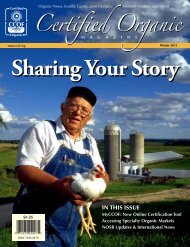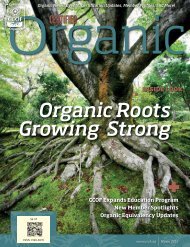HOME & GARDENDIAGNOSINGPLANT PROBLEMSBy Steven M. Zien, Executive Directorof Biological Urban Garden<strong>in</strong>g ServicesWHEN THE AVERAGE GARDENERsees a garden or landscape pest,they try to kill it, typically withtoxic pesticides. All too often even organicgrowers’ first action aga<strong>in</strong>st unwanted horticultural<strong>in</strong>truders are organically acceptablepesticides. These control strategies are onlytemporary solutions. Pests are only symptomsof the real problem. Treat<strong>in</strong>g only thepests does not elim<strong>in</strong>ate conditions thatfavor pest attack. The result is that the pesttypically returns, requir<strong>in</strong>g frequent andrepetitive treatments.Take a new approach to your pest managementstrategies for next season to helpyou successfully reduce or even elim<strong>in</strong>atepest damage and the need to use toxic pesticides.In order to manage a pest properly,you must first properly identify it (someth<strong>in</strong>gneglected by most gardeners). Thenyou must ask yourself: what conditionsfavor the pest outbreak? The answers tothis question will lead you to the appropriatestrategies to manage the pest withoutpesticides.Follow<strong>in</strong>g the step by step process belowwill help you determ<strong>in</strong>e the real cause ofyour pest problem. First, determ<strong>in</strong>e if a realproblem exists and def<strong>in</strong>e it. Look at theplant <strong>in</strong> question and properly identify it.Second, learn what a normal healthy plantof that species looks like at that time of year.Natural growth characteristics may mimicdisorders. Liquidamber trees have w<strong>in</strong>g likegrowths on the stems, which is perfectlynormal. Some broadleaf evergreen species(e.g., cork oak) shed leaves <strong>in</strong> early spr<strong>in</strong>gbefore new growth beg<strong>in</strong>s. These th<strong>in</strong>gs arenormal for these plants and should not beimproperly identified as pest related. Individualplant varieties are (for the most part)subject to specific <strong>in</strong>sects and diseases.Know the commonpests <strong>in</strong> your area andwhich plants they typicallyattack. When youare unable to identify aplant or are unfamiliarwith commonpests for specificplants<strong>in</strong> yourarea, yourlocal cooperativeextensionoffice should beable to identify the plant(take <strong>in</strong> a sample) andprovide a list of commonpests. You can also provide them a sample ofthe pest problem and they will identify thatfor you. Next, evaluate the entire plant, itssurround<strong>in</strong>gs, and how you have managedthe plant. Remember pests are only a symptomof the real, less obvious problem. Determ<strong>in</strong>eif obvious factors (e.g., excessive ordeficient water or light, excessive fertilization)are the real cause. This could stress theplant and make it susceptible to pests, result<strong>in</strong>g<strong>in</strong> problematic symptoms. Determ<strong>in</strong>ewhere the damage began. Symptoms andtheir location on the plant may help youascerta<strong>in</strong> the actual cause of the problem.It is important to realize that not allplant problems are caused by pests, and todist<strong>in</strong>guish between problems result<strong>in</strong>gfrom biotic (liv<strong>in</strong>g) factors and abiotic(non-liv<strong>in</strong>g) factors. There are general characteristicsfor each that can help you evaluatewhich might be the cause of your plantproblem. General characteristics of abioticfactors <strong>in</strong>clude similar symptoms of damageon several different plant species. Thesymptoms often appear on all leaves of acerta<strong>in</strong> age. Physical factors can <strong>in</strong>cludeexcessive or deficient irrigation (or ra<strong>in</strong>),temperature extremes and dry<strong>in</strong>g w<strong>in</strong>ds.Tak<strong>in</strong>g soil cores and check<strong>in</strong>g weatherrecords can help to confirm these disorders.Mechanical factors are often the result ofpoor ma<strong>in</strong>tenance or construction practices.They can <strong>in</strong>clude soil grade changes, soilcompaction, root cutt<strong>in</strong>g, lawnmower andstr<strong>in</strong>g trimmer <strong>in</strong>jury and girdl<strong>in</strong>g ork<strong>in</strong>ked roots. Chemical disorders which<strong>in</strong>clude nutrient deficiencies, excessive soilsalts, and phytotoxic pesticides (e.g., herbicide,<strong>in</strong>secticide, plant growth regulatordamage) may require soil and tissue analysisto confirm their <strong>in</strong>fluence. Attempt<strong>in</strong>g tocure these abiotic plant problems withapplications of pesticides (which is commonlydone) will only pollute the environmentwith tox<strong>in</strong>s and do noth<strong>in</strong>g to helpyour plants. Iron chlorosis (yellow<strong>in</strong>g leavesdue to a deficiency of iron <strong>in</strong> the plant)may be due to overwater<strong>in</strong>g or a high soilpH (above 6.8), rather than an actual irondeficiency <strong>in</strong> the soil. Add<strong>in</strong>g more iron tothe soil if the pH is too high will not fix theproblem. Only when the soil pH is lowered,mak<strong>in</strong>g the iron <strong>in</strong> the soil available,will plants get the nutrition they need.Borers are typically only symptoms ofthe real problem. Healthy plants can usuallyresist borer attack. Insufficient soilmoisture stresses the plants, mak<strong>in</strong>g themsusceptible to borer attack and damage.Biotic factors occur on one or only a fewplant species (e.g., fire blight only affectsmembers of the rose family). Damage typicallyprogresses with time. Indicators (e.g.,cast <strong>in</strong>sect sk<strong>in</strong>s, fruit<strong>in</strong>g bodies) can oftenbe seen with biotic factors. And justbecause you f<strong>in</strong>d a biotic factor attack<strong>in</strong>gyour plant, does not mean it is the causeof the problem. It likely is only a symptom.Aphids can be an <strong>in</strong>dication of excessivenitrogen fertilization. Switch<strong>in</strong>g to slowrelease organic sources of nitrogen can helpsolve the problem over the long term. Justtreat<strong>in</strong>g the aphids while cont<strong>in</strong>u<strong>in</strong>g withpoor fertilizer practices will encourage theaphids to return. Fungal diseases can affectall plant parts from roots to leaves. Theycan be displayed as leaf spots, powderymildew and root or crown rot. Bacterialdiseases affect leaves, stems, branches andtrunks (e.g., fireblight). Virus diseases areuncommon for landscape plants but canPage 20<strong>CCOF</strong> Magaz<strong>in</strong>e
occur (e.g., rose mosaic). Parasitic plants(e.g., broadleaved mistletoe) are typicallyeasy to see and identify. Diseases requirethe proper environmental conditions tobecome a problem. Identify the disease,learn its environmental needs and makenecessary management changes to elim<strong>in</strong>atethose conditions (e.g., change irrigationpractices, th<strong>in</strong> out trees over th<strong>in</strong> lawnarea to allow more light) and cure the diseasewithout pesticides. Most <strong>in</strong>sect pestdamage is not fatal to plants. Specific pestswill disfigure plants <strong>in</strong> characteristic ways.As feed<strong>in</strong>g cont<strong>in</strong>ues, the plant’s appearancegoes through predictable changes.Often these changes are observed beforethe <strong>in</strong>sects, which may be very small orcamouflaged.Don’t be fooled <strong>in</strong>to th<strong>in</strong>k<strong>in</strong>g that symptomsthat can be observed (e.g., <strong>in</strong>sectpests) are the problem that needs to betreated. Remember, healthy plants can usuallyresist pest attack. Identify the pest, butdon’t stop your <strong>in</strong>vestigation there. Learnwhat conditions favor pest development.Evaluate your management practices andenvironmental conditions and makechanges to reduce or elim<strong>in</strong>ate those thatfavor pest attack. Your pest problems willoften be solved without resort<strong>in</strong>g to pesticideapplications.Repr<strong>in</strong>ted by permission from BiologicalUrban Garden<strong>in</strong>g Services (BUGS), an <strong>in</strong>ternationalmembership organization (established<strong>in</strong> 1987) devoted to reduc<strong>in</strong>g ourreliance on potentially toxic agricultural chemicals<strong>in</strong> our highly populated urban landscapeenvironments. Members receive the latest environmentallysound urban horticultural <strong>in</strong>formationthrough the newsletter, BUGS Flyer—The Voice of Ecological Horticulture anda catalog of educational brochures. BUGS alsoprovides soil analysis with extensive organicrecommendations. For more <strong>in</strong>formation,contact BUGS at P.O. Box 76, Citrus Heights,CA 95611, or visit BUGS on the web:www.organiclandscape.comSTATE ORGANIC PROGRAMCOPAC MEETINGNOVEMBER 4, 2003By Sean FederTHE C ALIFORNIA O RGANICProducts Advisory Committee(COPAC) is an <strong>in</strong>dustry advisorybody set up under the California <strong>Organic</strong>Products Act of 2003. COPAC meets quarterlywith CDFA and DHS staff. RayGreen is the supervisor of the California<strong>Organic</strong> Program. Certifiers do not havea seat on the committee, however several<strong>CCOF</strong> certified producers are current representatives.<strong>CCOF</strong> staff attend COPACmeet<strong>in</strong>gs when possible.The November 4, 2003 meet<strong>in</strong>g washeld <strong>in</strong> Sacramento. Ray Green reportedthat they are still wait<strong>in</strong>g for the USDA toact on California’s application to becomean official NOP State <strong>Organic</strong> Program.This will grant CDFA and DHS theauthority for enforcement and adm<strong>in</strong>istrationof appeals under the NOP.The Federal <strong>Organic</strong> Certification CostShare program is cont<strong>in</strong>u<strong>in</strong>g through theend of September 2004. Certified operationsmay apply for 75% of their certificationcosts to be reimbursed (up to $500maximum). A surpris<strong>in</strong>g number of certifiedorganic operations did not apply forthe one-time reimbursement. Newly certifiedoperations or those that did not applythis past year should apply to CDFA toreceive their fund<strong>in</strong>g. The cost share applicationform is available at www.cdfa.ca.gov/is/fveqc/organic.htm, county agricultureoffices, <strong>CCOF</strong>, or by contact<strong>in</strong>g RayGreen’s office at (916) 445-2180.Former COPAC representative BryceLundberg addressed the committee regard<strong>in</strong>ggenetically eng<strong>in</strong>eered (GE) crops <strong>in</strong>California. He reiterated a message he hasput forth for the past two years—thatCOPAC should take a position to protectorganic growers fromrisks associated withthe <strong>in</strong>troduction ofGE crops. TheCOPAC/CDFAresponse has been torequest a survey oforganic registrants todeterm<strong>in</strong>e if there is asufficient consensuson this issue to warranttak<strong>in</strong>g a position.When Lundberg cameup with a survey, it was seen by some committeemembers as non-scientific. Lundbergexpressed some frustration with the California<strong>Organic</strong> Program’s stance. He felt that itshould be clear to representatives of organicgrowers that it is a major issue withouthav<strong>in</strong>g to send out a survey, and that thereis already sufficient published evidence thatGE has negative market implications. Hewould like to see <strong>CCOF</strong> consider send<strong>in</strong>gCDFA a petition from its members to helpdemonstrate that this is an important issue.At the recent meet<strong>in</strong>g, Gay Timmons,Chair, revitalized this concern and hastaken it on as a focus issue.W<strong>in</strong>ter 2003–2004 Page 21
















